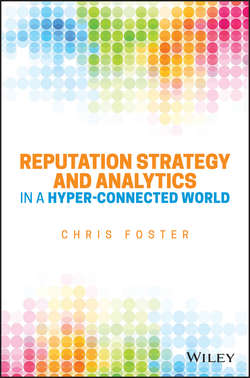Читать книгу Reputation Strategy and Analytics in a Hyper-Connected World - Foster Chris - Страница 14
На сайте Литреса книга снята с продажи.
Chapter One
Welcome to the Networked Ecosystem
ОглавлениеExecutive Summary: In a digital networked ecosystem with no clear time or physical boundaries, traditional strategies and tactics deployed by communication professionals will not work, and might even be harmful. Newer and more agile methods based on careful data analysis and scientific reasoning are required.
These days, it seems as though every executive feels obligated to talk about the critical need for collecting data, managing data, analyzing data, storing data, and harvesting insights from data. All of those activities are important, but what’s even more important is creating a corporate culture in which data is respected, valued, and understood. From my perspective, the primary barrier to extracting value from data is culture, not technology.
The processes of data science are inherently collaborative and cross-disciplinary, which essentially means you cannot do data science in a vacuum. It cannot be relegated to the basement or to a back room. It’s a team sport. There are plenty of moving parts that require careful orchestration and dedicated leadership.
Too often I see data siloed in specialized groups or I hear people talking about using data to generate insights. Your organization can have all the insights in the world, but they will not help unless you have a culture that knows how to transform those insights into ideas and effective decisions.
In the twenty-first-century economy, data is the fuel we use to make better decisions. It’s the raw material from which we manufacture success. We have to use that data and then take action.
Changing the Culture
Saying that an organization is “data driven” doesn’t mean it’s being run by computers. It means that key decisions are informed and influenced by evidence, which is derived from data. Not every decision needs to be made by human beings – an increasing number of decisions can be delegated to software applications and other forms of automation. For example, you don’t need a human to decide whether to turn on the air conditioning in the summer. That kind of decision can and should be automated.
For the most part, we’re fine with delegating straightforward decisions to machines. But now there’s a widening area in which we’re not so sure how much decision-making power we really want to share with our software applications. For example, farmers used to decide when to water their crops. Now, exquisitely complex systems of machinery, software, mobile devices, and sensors – including cameras mounted on airborne drones and orbiting satellites – decide when it’s necessary to turn on the spigot.
The real question facing us is whether we want to use our increasingly sophisticated decision-making technology not just to grow better grapes and keep our shopping malls cool in the summer, but to improve the performance of our companies and organizations.
The question that executives should be asking is not about technology. For the most part, the technology you need to make better decisions is already available. The question executives need to ask is this: How do we transform our organizations into data-driven cultures?
The Digital Revolution Has Rewritten the Rules
It’s not exactly fresh news that digital information technologies have changed everything, but it’s worth repeating: Digital information technologies have changed everything.
On many levels, we all understand that we’re living through a revolution, but the reality has not fully set in. In the communications industry, for example, most of us pay lip service to “new media,” but few of us are genuinely comfortable operating within the digital environment, which now surrounds and envelops us so completely.
Some of my best friends still pine for “the good old days” when most of our business was done at lunches or over the phone. I also experience a twinge of nostalgia and fondness for the past. It’s only natural. In the past, everything was easier, simpler, and slower. Or at least, it seems that way.
What we had then, that we don’t have now, is a routine. There is no well-worn path or standard operating procedure – yet. For decades, we relied on a comparatively narrow set of reflexive responses to whatever challenges came our way. Table 1.1 is a gross simplification, but it will remind you of how we typically dealt with problems before everyone had a computer, a smartphone, and a Facebook account.
Table 1.1 Typical Responses of Functional Silos Operating within Traditional Organizations
Collaborating, Crowdsourcing, and Co-Creating
Modern digital technologies don’t merely help us manage larger amounts of information more quickly – they enable us to interact with the information we handle. We are no longer passive customers of information – we sample it, we modify it, and we share the results of our improvised tinkering across the social networks that we help to create. Today, everyone is a publisher.
In the past, developing and distributing content required significant upfront investments of capital. You needed lots of money to buy printing presses and television transmitters. And you needed even more money to hire people with the skills, talent, and experience necessary to create content that you could distribute profitably to a large audience. Publishing and broadcasting companies were run like factories – products were manufactured from component materials and then distributed through various channels to customers.
Конец ознакомительного фрагмента. Купить книгу
